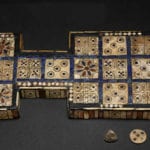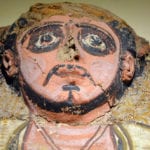 History
History  History
History  Weird Stuff
Weird Stuff 10 Superstitious Beliefs That Once Consumed Entire Cultures
 History
History 10 Bizarre Friendly Fire Incidents in Military History
 Technology
Technology 10 Modern Technologies That Accidentally Imitate Ancient Magic
 Mysteries
Mysteries 10 Mysteries of the Human Genome
 Weird Stuff
Weird Stuff 10 Things So Rare They’ve Only Been Found Once
 History
History 10 Legends Whose Last Moments Undid Their Glory
 Health
Health 10 Futuristic Ideas to Treat Common Medical Problems
 Weird Stuff
Weird Stuff Ten Surreal Attempts to Reverse Baldness
 Facts
Facts 10 U.S. Government Contingency Plans for the Unthinkable
 History
History 10 Odd Things Colonial Americans Kept at Home
 Weird Stuff
Weird Stuff 10 Superstitious Beliefs That Once Consumed Entire Cultures
 History
History 10 Bizarre Friendly Fire Incidents in Military History
Who's Behind Listverse?

Jamie Frater
Head Editor
Jamie founded Listverse due to an insatiable desire to share fascinating, obscure, and bizarre facts. He has been a guest speaker on numerous national radio and television stations and is a five time published author.
More About Us Technology
Technology 10 Modern Technologies That Accidentally Imitate Ancient Magic
 Mysteries
Mysteries 10 Mysteries of the Human Genome
 Weird Stuff
Weird Stuff 10 Things So Rare They’ve Only Been Found Once
 History
History 10 Legends Whose Last Moments Undid Their Glory
 Health
Health 10 Futuristic Ideas to Treat Common Medical Problems
 Weird Stuff
Weird Stuff Ten Surreal Attempts to Reverse Baldness
 Facts
Facts 10 U.S. Government Contingency Plans for the Unthinkable
10 Unresolved Questions about Ancient Rome
Ancient Rome will likely forever be a focal point for historians and archaeologists. We know an astounding amount about their culture, citizens, and long dominant reign. But there’s still plenty we don’t know. Despite the Romans’ ability to document their history fairly well for the time, mysteries inevitably remain. And since Rome’s height of power came centuries ago, there are undoubtedly things we will never know about the world-changing society.
In this list, we’ll do a deep dive into ten unresolved questions about ancient Rome. Archaeologists and historians alike still wonder about the puzzles presented here. Maybe one day, they’ll find answers clear enough to their liking. Or maybe they won’t—and these mystifying mysteries will remain unsolved for eternity!
Related: 10 Ways The Roman Empire Was Surprisingly Progressive
10 The Skulls of Walbrook Valley
In 2013, workers on London’s Crossrail project made a startling discovery while digging a tunnel on Liverpool Street. They stumbled upon a few dozen human skulls that turned out to be much older than expected. When archaeologists got a hold of them, they were able to date the bones back to the Roman period.
Interestingly, this wasn’t the first time such finds were made in the area. In the 1980s, archaeologists uncovered 39 Roman skulls in the nearby Walbrook Valley. The origin of these skulls and the reason behind their disarticulation remain a mystery. But, of course, the finds have sparked various theories.
One theory suggests these skulls may have been victims of Boudicca, the Queen of the Iceni, who attacked Londinium in AD 60. Another possibility is that the site served as an ancient cemetery that gradually eroded over time. Thus, the remains slowly washed downstream through erosion. Other historians wonder if these modern-day workers had come across the site of a mass murder or execution.
Alternatively, it’s speculated that Roman Londoners practiced the “cult of the head” from the Iron Age. In that form of faith, decapitated heads would have been used for rituals and sacrifices. Thus, finding such a small area concentrated with dozens of skulls would seem to make sense. While these ideas hold some plausibility, none have been proven conclusively. Today, archaeologists are still searching for definitive answers. [1]
9 Mysterious Mithraism
In ancient times, some Roman practices were kept hidden from the public. Thus, that leaves us with little knowledge about them today. Mystery cults, popular in the Greco-Roman world, kept their rituals and traditions a secret known only to initiates. Sadly, no written records exist of these events. And so, many of these secrets have been lost to time.
One well-known example is the Eleusinian Mysteries. That was an ancient Greek celebration honoring Demeter. And Rome had its own secretive parallel religion centered around the god Mithras. That faith angle was possibly influenced by the older Zoroastrian god Mithra. However, the true connection between the two remains a subject of debate.
Mithraism emerged in Rome during the 1st century AD and rapidly spread throughout the empire. Devotees congregated in underground temples called mithraea. Over 400 ruins still stand as evidence of the widespread influence of this pagan religion. So we know it was popular, widespread, and very common. Yet, without any surviving texts about the cult’s rituals and traditions, the Mithraic Mysteries will forever remain an enigma.[2]
8 Villa of the Mysteries
Just outside the ancient walls of Pompeii, atop a hill that once overlooked the city, lie the remains of several villas. Among them, one stands out as a remarkable testament to the past. It has thus far defied the ravages of time and the destructive forces of the volcanic eruption. This villa, over 2,000 years old, remarkably retains much of its original structure. Plus, its walls reveal an astonishing sight: elaborate, detailed, and captivating frescoes.
At the heart of this ancient dwelling lies a room that appears to have served as a dining area. It’s roughly 15 x 15 feet (4.5 x 4.5 meters) and would have been exquisite. Three of its walls boast a continuous fresco wraparound. It depicts numerous figures immersed in various activities against a striking red backdrop. It is this room that has earned the villa its name: Villa of the Mysteries.
But why the mysterious title? The true meaning behind these enigmatic frescoes remains elusive. Scholars speculate they might offer a glimpse into one of Rome’s little-known mystery cults. Perhaps those dining inside at the time were associated with Dionysus. However, alternative theories propose that the scenes depict a bride on her wedding day. Some even wonder if they may portray excerpts from a theatrical performance. The exact significance of these captivating artworks remains an enigma. They sure are beautiful and rare, though![3]
7 The Hertfordshire Dodecahedron
In 1739, an intriguing discovery was made in Hertfordshire, England. It was a Roman artifact—but it wasn’t just any artifact. It was a meticulously crafted metal dodecahedron with 12 faces. Along with that, it featured small knobs on its edges and varying-sized circular holes on each face. Since then, more than a hundred similar Roman dodecahedrons have been found across Europe. Most of them have turned up in the former Gaul region of the Rhine basin. However, despite extensive research, the purpose of these enigmatic objects remains unknown.
Unusually, the Romans left no written records or mentions of these peculiar metal items. Scholars have scoured historical texts from the Roman and Greek civilizations. They’ve even looked deeper into neighboring allies and rivals too. But unfortunately, they have found no clues.
As a result, numerous theories have emerged proposing various uses for the dodecahedrons. Some suggest they were mere decorative pieces or playthings. Other historians propose their function as measuring instruments, astronomical tools, mystical objects of ceremonial significance, or even weapons like mace heads or projectiles. But answers haven’t been coming. Now, unless an ancient text surfaces to unravel the mystery, the true purpose of the Roman dodecahedrons is likely to remain concealed.[4]
6 The Puzzle of Silphium
Imagine living in ancient Rome and suffering from ailments like indigestion or a sore throat. In such situations, the go-to solution was the incredible herb known as silphium. It was a miracle worker of the era. Citizens used it to treat a wide range of maladies. It was even known for its aphrodisiac and birth control properties.
Silphium was so highly sought after by the Romans that its value rivaled that of gold. Not only was it used for medicinal purposes, but it also found its way into cooking and perfumes. It was even incorporated into the diets of sheep, making their meat exceptionally tender and flavorful. Every part of the plant, from the roots to the leaves, had its own practical use. Silphium truly had it all. The question, however, remains unanswered—what exactly was silphium?
Sadly, we can’t provide a definitive answer because silphium no longer exists. The Romans are believed to have harvested it to extinction. All we have today are records of its remarkable properties from ancient writings. In fact, even Pliny the Elder mentioned he had only heard of a single stalk of silphium being found during his lifetime. That was promptly sent as a gift to Emperor Nero. And from there, well, silphium was history.
That gifting event took place in the 1st century AD. Thus, historians believe silphium had all but disappeared well before that. Or did it? Some hold onto the possibility that silphium still exists. Biologists wonder if it’s hiding in plain sight under a different name. Others speculate it could have been a hybrid herb at the time and unknown to us today. Both camps cling to the hope that silphium might someday make a surprising comeback. But so far, it hasn’t—at least not in a way that’s been made clear to the modern world.[5]
5 The Lost Roman Legion
The Romans were known for their meticulous recordkeeping in all things. So that’s what makes the disappearance of Legio IX Hispana, an Imperial Roman Army legion, a mystery that still puzzles historians. This legion, whose origins are uncertain, played a role in Caesar’s Gallic Wars. Then, they had a documented history until AD 109. At that time, it was said to be stationed on the northern border of Britain to protect against Scottish tribes.
Fast forward over half a century to the reign of Marcus Aurelius. During that era, an inscription listing all Roman legions failed to mention Legio IX Hispana. This suggests something significant—and destructive—happened to the legion during that period. Previously, it was believed the entire legion was destroyed during a siege against the Picts in Scotland in AD 117. But there’s no record of that, either. And thus, nothing is certain.
To make things even more bizarre, recent investigations have uncovered evidence of the legion’s presence in Germania Inferior after AD 121. Another theory proposes that the legion met its demise during the Bar Kokhba Revolt in Judea in AD 132. But concrete proof of that is lacking, too, thus rendering it a mere hypothesis. The fate of Legio IX Hispana remains shrouded in uncertainty. Where could they have gone? When could they have met their demise? Why weren’t they listed on the census during Marcus Aurelius’s reign?[6]
4 Baiae’s Tunnels
Long ago, Baiae was a fancy vacation spot for rich Romans who sought relaxation in the hot springs beneath the town. But over time, volcanic activity caused Baiae to sink into the sea. Today, it lies as a ruined mix of above-water and underwater remnants. While archaeologists have studied most of the town, one mystery remains: the Baiae Tunnels.
These tunnels weren’t exactly welcoming. Hidden and inconspicuous, they appeared as a small, dark opening in a hillside. Peering inside, all you’d find was a narrow, hot passage. And that tiny slit was filled with darkness and an unpleasant smell. Not exactly attractive to guests!
In the 1960s, two amateur archaeologists, Robert Paget and Keith Jones, ventured into the depths. They hoped to uncover the legendary “cave of the sibyl,” where prophecies were supposedly made. Their exploration revealed a labyrinth of tunnels that Paget called the Great Antrum. It included flooded sections and buried dead ends.
Paget believed these tunnels represented a journey to the underworld. He even went so far as to say it was akin to the one described in Virgil’s Aeneid. He even wondered if Virgil himself had been part of a secret cult and had traversed these tunnels. However, most scholars aren’t convinced. Although it’s likely that these tunnels served some ceremonial or religious purpose, their true significance remains unknown.[7]
3 The “Burrito” Sarcophagus
Unveiling mysteries from the ancient world, our next discovery takes us to the city of Gabii. Over a decade ago now, archaeologists stumbled upon an extraordinary sarcophagus there. The one they found was unlike any other. Dating back 1,700 years, this lead coffin weighed nearly 1,000 pounds (455 kilograms). It also possessed a notably peculiar design.
Unlike the rectangular shape commonly seen, this sarcophagus was folded over itself. In that way, it resembled an enormous lead “burrito.” The question from archaeologists was obvious: who rests within this enigmatic tomb? Given the high value of lead in that era, it is unlikely that nearly anyone could afford such an extravagant coffin. Speculations abound even today. Some have suggested it could be a priest, a dignitary, or even a celebrated gladiator.
Sadly, the mystery persists with no answer in sight. The thick one-inch sides of the sarcophagus have defied conventional non-invasive methods of analysis like X-rays and CT scans. Attempts to forcibly open it risk damaging the remains inside. Archaeologists obviously don’t want to do that. Thus, for now, the sarcophagus remains sealed. And until that changes, it will only leave us all in perpetual wonderment.[8]
2 Chemical Warfare at Dura-Europos
In 256 BC, an intense clash occurred between the Romans and the Sasanians. The fighting took place during the awful Siege of Dura-Europos in modern-day Syria. The Romans occupied the border town and faced an enemy tactic that caught them off guard. The Sasanians cunningly dug tunnels beneath the town’s outer wall. That prompted the Romans to respond with their own countermines.
When the opposing forces finally collided, the Sasanians had a devastating surprise ready. They ignited braziers containing pitch and sulfur. That created a lethal cloud of sulfur dioxide. Within the confined space, this toxic cloud inflicted coughing, burning sensations, breathlessness, and pulmonary edema. Ultimately, it became a death trap for charging Roman soldiers, ending in tragedy.
The chaotic conditions of panic, darkness, and claustrophobia hindered the Romans from retreating in an organized manner. The gaseous assault was reported to have claimed the lives of 20 soldiers on its own. That would make it potentially the earliest documented case of chemical warfare in history. Sadly, we don’t know much more about the siege or its aftermath. While Roman writings seem to document some kind of chemical attack, it’s uncertain beyond that. Historians are almost certain the Sasanians’ surprise was a pioneering move in war—but we’ll never quite be sure.[9]
1 Titus Livius’s Work
Rome stands as one of the most extensively documented ancient cultures. Thanks to their commitment to recordkeeping, diligent historians chronicled their history in great detail. One such historian was Titus Livius, also known as Livy. He embarked on the monumental task of writing the 142-volume work called Ab Urbe Condita, or From the Founding of the City.
This impressive chronicle covered Rome’s history from its humble beginnings as a kingdom through its republican era and spanned 500 years. It even went all the way up to its transformation into an empire during Livy’s lifetime.
However, while Livy’s work shed light on lesser-known periods like the Roman Kingdom, much of it has been lost over time. Out of the 142 volumes, only 35 have been recovered in their entirety. But ironically, Livy’s passion for extensive documentation led others to create condensed versions of his books. The most famous among them is The Periochae. It eventually surpassed Livy’s original work in popularity due to its accessibility. In some ways, it was the original version of Cliffs Notes!
In the end, Rome’s remarkable historical legacy owes much to the meticulous recordkeeping efforts of historians like Livy. But because only certain fragments of his groundbreaking works survive, we only know so much about his world. It’s fascinating and humbling to think about what might have been lost to history through the centuries.[10]








